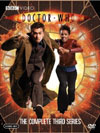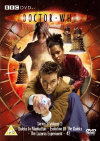42
 |
 |
 |
DVD NTSC
Region 1
14-episode
box set




|
DVD PAL
Region 2
14-episode
box set


|
DVD PAL
Region 2
plain 4-episode volume


|
|
(Doctor Who Story No. 188, starring David Tennant)
- written by Chris Chibnall
- directed by Graeme Harper
- produced by Phil Collinson
- music by Murray Gold
- 1 episode @ 45 minutes
|
Story: The Doctor and Martha find themselves on an
overheating cargo ship that has 42 minutes left before
freefalling into a sun in the Toragy system. What mysterious
medical problem has the Captain's husband come down with?
Who or what has sabotaged the engines? And why are Martha's
phone conversations with her mother being monitored?
|
|
DVD Extras (box sets only) include:
- Audio commentary by writer Chris Chibnall
and executive producer Russell T. Davies.
- Doctor Who Confidential featurette: Space Craft (12 min.) adding
David Tennant (The Doctor),
Freema Agyeman (Martha),
Michelle Collins (McDonnell),
Anthony Flanagan (Scannell),
director Graeme Harper,
production designer Edward Thomas,
visual effects supervisor Barney Curnow, and
visual effects producer Will Cohen.
- David Tennant's Video Diaries
- Behind the Scenes of "42" (9 min.) with
Tennant, Agyeman, Chibnall,
script editor Simon Winstone,
Rebecca Oldfield (Erina Lissak),
gaffer Mark Hutchings,
1st assistant director Gareth Williams,
art director Lee Gammon, and
costume assistant Kirsty Wilkinson.
- Behind the Scenes of "The Weakest Link" special
Doctor Who tournament (9 min.) with
Tennant, Noel Clarke, John Barrowman,
Camille Coduri, John Leeson, Mat Irvine, Nick Briggs, and Claire Rushbrook.
- Out-Takes & Bloopers
Buyers' Guide Review
by Martin Izsak
|
|
(A more in-depth analysis, containing "SPOILERS" and intended for
those who have already seen the program, can be accessed
here.)
|
Season 29 finally returns to its above average offerings with this
worthy adventure. Chris Chibnall delivers a script teeming with
excellent elements and ideas, inspiring master director Graeme Harper
and his cast and crew to another enjoyable success - the best story since
the season opener
"Smith and Jones" (story no. 183).
The idea of answering a distress call in space remains a great way
to believably bring our regular characters into an excellent adventure
in an interesting place, and it's surprising that this hasn't been used
more often since the show's 2005 revival. Thus
from early on, the writing forms a logical path for revealing the setting
which works well enough, but sadly skimps on the materialization effect
for the TARDIS that would help brand new viewers understand the show better
and give the tale greater repeat viewing satisfaction. This is happening
too often on the better stories this season, and without any other
satisfying TARDIS movements in the rest of the story, the adventure
will have to take a minor minus mark here.
That said, the setting and main challenge are laid out with clarity
and gusto in this opening, perfectly setting the audience up to understand
the episode's bizarrely different title. Perfect. One can argue that
the setting isn't all that much more original than the season's other
offerings, with the exterior and associated computer voice messages
paralleling "The End of the World" (story no. 162)
quite closely, and the spaceship interiors paralleling the interiors
of "The Impossible Planet" (story no. 178)
in their gritty, industrial stylization of future space travel. Fine and
dandy, but also note that I ranked those two stories at the top of their
respective seasons, in part because of the imagination that went into
their environments, and you will understand why "42" is giving us more
of a good thing.
It's also sweet icing on the cake to hear the bit of dialogue near
the beginning of the tale, when the Doctor satisfies his curiosity to
know exactly where in the galaxy we are. It's the Toragy system, half
a universe away from Earth, and not constrained by any of the numerous
past, present, and future histories of Earth that we have learned from the
show so far. That leaves so many possibilities open for
the adventure to go in surprising new directions. And explore those
directions it does.
Of course, I won't fully discuss this aspect and reveal potential
spoilers here, much as it burns me not to. "Burn with me" (pun intended,
of course) in the In-depth Analysis version
of this review, for a wider interpretation of one of this story's
more interesting ideas....
The plot proceeds along the typical formulae for a bottle story,
with just enough whodunit thrown in to keep things interesting. As such
tales go, this one is much better constructed than "The End of the World".
Many typical story beats have the regulars and guest characters learning
to work together to solve problems and put out fires,
providing us with a base level of satisfaction. The counter stratagems
of the antagonist's forces are also logical and believable, while
maintaining a good deal of mystery until later stages of the story.
But while the tale could rest on its laurels here and still be guaranteed
a successful standard, it goes on to include a few unanticipated story
beats as well.
The guest characters are perhaps a bit less memorable than those of
both "The Impossible Planet", which had twice as much time to develop
its characters, and "The End of the World", which spent so much time
parading them as caricatures that little time was left to involve them
in a truly engaging plot. But the characters in this story remain a bit
more enigmatic, and get the most believably "unstaged" introductions of
the three stories. It is very cool to have the Doctor repeat their names
as he meets them, often with far more clarity than their own Welsh accents
could provide, because that helps him, and consequently the audience,
remember their names when the end credits finally roll.
Director Graeme Harper has definitely worked his magic again
on this one, creating a compelling atmosphere and a driving pace that
keeps viewers glued to the screen and wanting to know what will happen
next. Even for those who have already seen it, there's enough here to
still be taken by surprise on repeat viewing. The one drawback to the
story may be the large quantity of technobabble that is rushed through,
both by actors with Welsh accents that are too thick to be easily
understood outside Wales when speaking invented jargon at that speed,
and by the Doctor who often rushes through too much jargon too quickly
as well.
|
It is quite sad that none of the new music composed and performed
specially for this episode ended up on the season's music CD. Murray
Gold does a lot of super-cool stuff with percussive rhythms & beats,
as well as some great invention of unconventional augmentation
sounds & instrument choices, giving the story's audio track a disturbing
hypnotic magnetism that further helps to keep viewers glued to the
screen. Although a bit too cliché techno at the end of the
first sickbay scene, the rest of the new music transcends its techno
roots to become simply compelling. Excellent stuff - and one of the
best repeat-listening scores of the season.
Several of the season's more recognizable themes are back as well,
while one that is better known for another story actually makes its
slightly out-of-place debut here. Perhaps most memorable amongst
re-used music, however, is the very distinctive style of "stings"
heard in "The Impossible Planet", making the comparisons between that
story and this one even more obvious.
|
Music by Murray Gold
"All the Strange, Strange Creatures",
"Martha's Theme", "The Doctor Forever",
and "The Master Vainglorious"
are available on:
"The Impossible Planet"
is available on:
|
|
One of the more disappointing aspects of the story is handed down from
the executive producers: all the screen time spent finally acknowledging
Martha as a proper companion. It's simply too late in the season for this
to still be interesting, and we end up reliving too many of Rose's
scenes from "The End of the World" and elsewhere that were never a good idea
in the first place. Anything centered around the ridiculously magical
cell-phone is the worst offender for me, with the conversations with her
Mum being one of the most boring aspects of the story, and to quote her
Mum's most accurate observation, most unwatchably, unpleasantly "rude".
At other times, Martha's speech seems to have fallen into an ugly parody
of Rose's, turning "th's" into "f's", and adding "yeah?" on the end of
her statements to make them questions that beg for agreement. Ick.
And weird, since Martha thankfully hadn't seemed to have ever spoken
this way on the show previously.
However, when all is said and done, the Mr. Saxon angle is presented
in the most intriguing fashion yet this season. Nice job. Much, MUCH
better than what we got in the last story. Thank you, Chris Chibnall.
On first viewing, however, it was still far less than what I'd hoped for.
It was starting to feel like the season had really delayed
too many important things for far too long to remain well-constructed.
In the end, "42" is an engaging story that can be proudly held up
as one of the better ones of season 29, and probably the one that most
closely relates to the glowing fire / mad race imagery of the season's
box set cover. Chris Chibnall is a much welcome new writer to the Doctor
Who team, and I hope he has a chance to pen another story for the show
soon.
This story has become available on DVD.
Click on the Amazon symbol for the location nearest you
for pricing and availability:
 |
 |
 |
DVD NTSC Region 1
14-episode boxed set
for the North American market:




|
DVD PAL Region 2
14-episode boxed set
for the U.K.


|
DVD PAL Region 2
plain 4-episode volume
U.K. format only


|
Note: The full season sets
contain commentaries, behind-the-scenes
featurettes, and other extras.
The smaller volumes only feature the plain episodes.
Comments on this article are welcome. You may contact
the author from this page:
Contact page

LYRATEK.COM
|
Read the Buyers' Guide Review for the next story:
"Human Nature"

|
|










